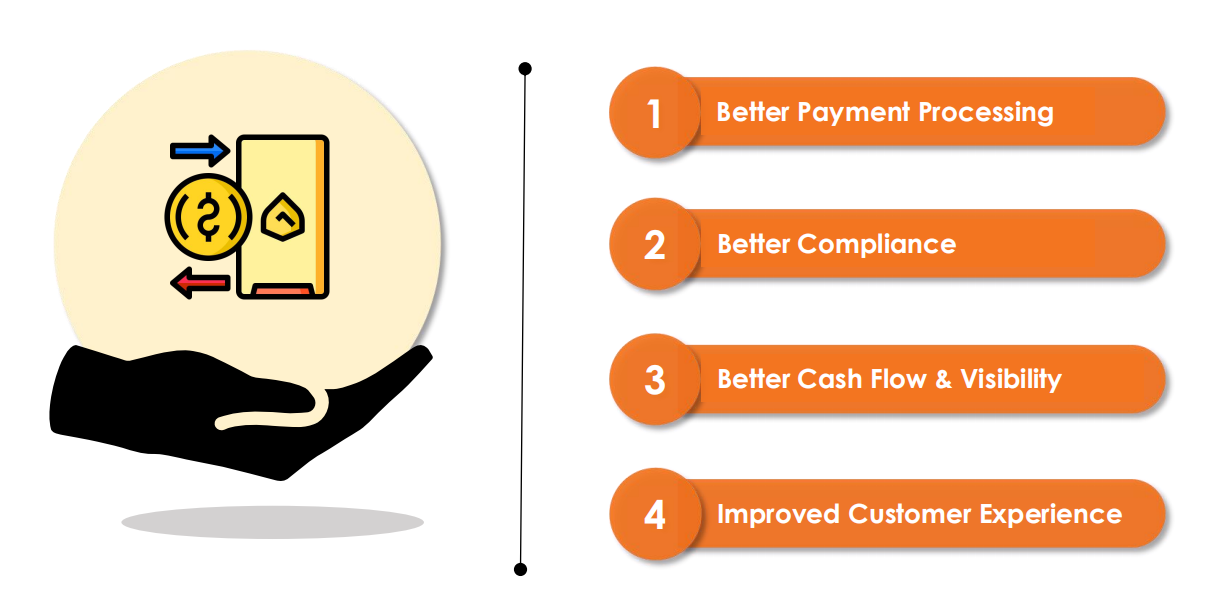A Map to Curb Challenges
This e-book outlines the changing dynamics in the B2B payments landscape within mid-sized businesses. Understand the challenges involved in traditional payment methods and how it affects the overall cash flow. Explore key market trends and emerging digital payment methods that provide opportunities to improve cash flow and make a positive impact on working capital
A Map to Curb Challenges
4.1 The Future with Digital Payments: Multiple Payment Formats, RDC and Mobile Payments
In order to have a competitive advantage, businesses need to accommodate the buyer’s preferred method of payment. The availability of multiple payment formats such as Same-day ACH, Virtual Cards and Wire makes it possible for businesses to get real-time payments.
Digital payments are not just limited to cards and payment portals, businesses are now taking advantage of Remote Deposits for check payments. Customers can conveniently make remote check deposits using a mobile device. On the customer side, this saves a lot of time, money, and efforts of having to go to banks for making a physical deposit. The adaptability of these payment formats helps in taking better cash management and working capital decisions.

Figure: Remote Deposit Capture Process
4.2 Benefits of Enabling Digital Payments
1. Better Payment Processing
- Faster reconciliation: As compared to paper-checks which can take days to be processed by banks and finally reflect in the A/R, digital payments are real-time. This means that payments get applied and updated simultaneously in the open A/R as customers pay for invoices via integrated payment portals.
- With the availability of payment portals, customers can choose to pay for individual or multiple invoices at the same time. As particular invoices are already accounted for in this method, businesses can focus on higher-value tasks instead of manually reconciling individual payments with remittance and invoice information. This removes the risk of human error and provides better control of finances.
- Lower Processing Costs: The cost of manually processing paper checks is a lot higher as compared to processing digital payments. Owing to the reduced manual intervention and reconciliation efforts, digital payments are more cost-effective as compared to traditional payment methods.
2. Better Compliance
To maintain a secure payment framework – Payment Card Industry (PCI) compliance is mandated by credit card companies. The Payment Card Industry Data Security Standard (PCI DSS) is defined as a set of requirements that ensure secure processing, storing, or transmission of credit card information.
New age PCI DSS compliant solutions provide a frictionless experience by protecting the business along with their customers’ data. This ensures that the payment information is securely handled. Electronic payments are offered with multi-layered security that encrypts the payment information. For example, virtual cards use the method of tokenization which restricts payment to a fixed amount of transaction. This process can provide better working capital benefits with improved control of the overall cash flow. Opting for a PCI DSS compliant solution may come with high costs so it’s advisable to carefully read through the payment terms before settling on a solution.
3. Better Cash Flow and Visibility
- Improved Cash Flow: In today’s economy, enabling customers to pay in their preferred format could make all the difference between getting paid and accounts going delinquent. With digital payment formats, businesses not only get payments in their bank accounts instantly but they could also fast-track processing for a faster cash conversion cycle.
- Better Visibility: Digital payments allow access to real-time revenue performance with strategic insights for better cash management. With a digitized framework, businesses can track open A/R and payment trends to identify potential risks and delinquent accounts.
4. Improved Customer Experience
The availability of multiple payment formats makes it easier for customers to pay for invoices on time. This will result in a reduction in the overhead of the open A/R.

Figure: Benefits of Enabling Digital Payments

